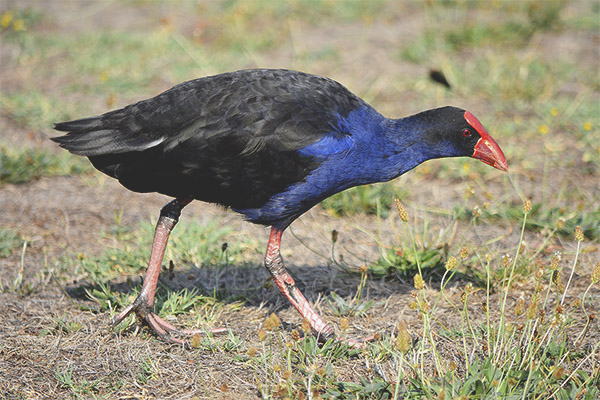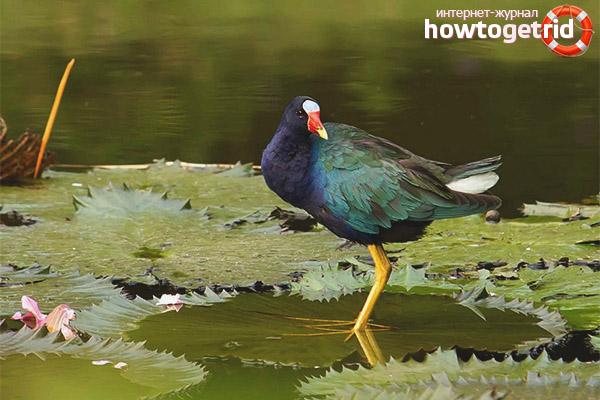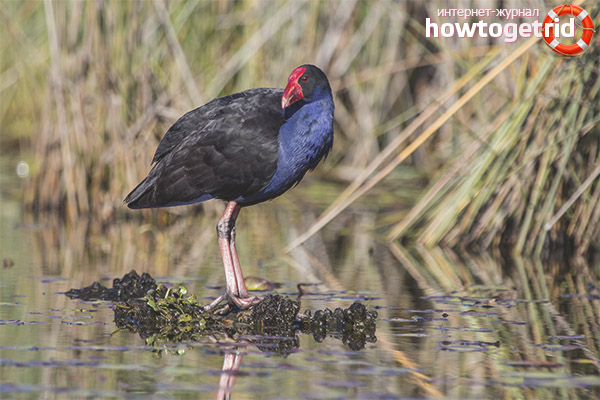The content of the article
It is very often heard that the sultan is called the sultan's chicken. This is a large bird, you can compare it with black grouse.
Description of Sultan
The body is 45-55 cm long, and it can weigh from 0.5 to one kilogram. In relation to the body, the head is large in size, but the neck is small and short. The wide beak, slightly swollen, is bent at the end. In size it is small, but sharp.
Legs strong, long average. The fingers are rather thin and long, sharp claws. Both females and males on the head are spotted in red. Wings in scope can reach 30 centimeters. Feathers are dense, plumage dense.
The colors of the sultanka are almost not dominated by bright colors, but despite this, they are in perfect harmony. From above the bird is all black, and the belly, neck and chest are of dark blue color.In some sultanas, you can still see the light green color. The bird is divided into several subspecies, some of them have a white tail. Sultans are distinguished by a bright red color on the head and in the region of the beak. With the onset of cold weather, red fades. The legs are pink.
Habitat Sultanka
The bird lives covertly, it is not in sight of people, of course, it is possible to meet it, but not often. In the wild, it is very rare. But this is someone as lucky.
Nutrition
Leaves, flowers, seeds, and, of course, a lot of other vegetation prevail in the bird’s diet. Animal food is no exception; they love beetles, mosquitoes, butterflies, flies, grasshoppers, etc. In small quantities they can eat frogs and mollusks.
If it is difficult to get food and it is very small, then the sultan can climb into someone else's nest, pick up eggs from there. It happens that eats carrion. Most food is harvested in grass or in shallow water.
Reproduction of Sultan
Sultan chicken is a monogamous bird. When the breeding season comes, they are not always formed in pairs, often combined into groups. A group can consist not only of couples, but also of single birds. Birds begin to breed as soon as it starts to warm up or it rains. The nesting takes place very near the water or even on the water. For the construction of nests choose grass or reed. Nests are usually well hidden in the vegetation. Both partners are engaged in housing construction. The male, as a breadwinner, brings construction material, and the female already creates a nest from it.
In one breeding period, the female may have from 2 to 6 eggs, they are demolished in turn, every other day. Hatching eggs together, from 3 to 5 weeks, as the male produces food during this period. Newborn chicks hatch almost all the same, at the same time. Toddlers covered with thick black fluff. During the first week of their life, they are in a nest under the supervision of parents and helpers who feed and warm them.In two weeks the chick is already able to get food to itself, and in two months it starts to fly.
Sultan lifestyle
The sultan eats more food of plant origin, but this is in the summer, and with the arrival of cold weather, carrion predominates in her diet. Nesting occurs not only in separate pairs, but in whole groups. They become a big family, together they participate in breeding chicks.
They build nests on stagnant water, if there is a flow, then they choose the nearest bump. During nesting by a large group, several females may lay eggs in one nest. Sultan prefer to run and move more on the ground than to fly. It can take off if it is disturbed or frightens something, but usually this flight is not more than ten meters, after that the birds are looking for a secluded landing place for themselves, most often choosing dense thickets for this.
Sultan doesn’t like to change her habitat often, which is why her way of life is sedentary, most often they settle near the shores of reservoirs, rivers, lakes and seas. Sometimes it can be thick and high grass thickets, a place where a lot of reeds or reeds grow. So it is easier and more convenient for them to get food.
The shepherd bird is a rare species located on the periphery of the range. The sultanka is a southern bird, and it is not adapted to cold, harsh winters. With the arrival of cold weather, the place on the water where the bird nests, freezes, the bird must move to the shore, where it becomes difficult to get food, and the conditions for a normal existence are not the most favorable. So they turn into prey for predatory animals and poachers. The fox, the wolf, the wild boar and the crows are the most terrible enemy for the sultan.
Interesting facts from the life of the Sultan
- Sultan is often called sultan's chicken. The color of this bird changes very often, it can be dark blue, then change to green ebb, or to tar black.
- Some birds have a light pink chest with an ashy tint, and on the rest of the plumage mottles appear.
- The sultan bird, according to scientists, is divided into 24 subspecies.Not in all cases the sultan is a bird. With such a name, there is still a commercial fish from the perch squad.
- The bird is sociable and talkative; among themselves they often engage in dialogue. From the outside, these shouts are like whistling or screeching, but very loud.
Video: Sultan (Porphyrio porphyrio)













To send